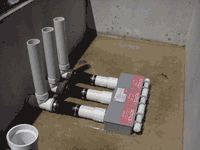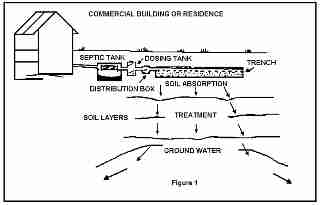 Using Gravity, Siphon, or Float-Controlled Effluent Dosing as a Component of Alternative Septic Systems for Difficult Sites
Using Gravity, Siphon, or Float-Controlled Effluent Dosing as a Component of Alternative Septic Systems for Difficult Sites
- POST a QUESTION or COMMENT about septic dosing systems that do not require a pump or pressure nor electricity.
Septic Dosing Systems:
Float-controlled, gravity-controlled, siphon-controlled: this septic system design article defines, describes, and explains the operation of the types of effluent gravity dosing septic systems, including gravity dosing, using septic effluent tipping buckets, tipping pans, or dipping systems, bell siphons, or float-controlled (floating outlet) effluent dosing systems for septic system effluent final treatment and disposal.
We explain how non-electric float or gravity-operated septic dosing systems are designed, installed, and how they work.
InspectAPedia tolerates no conflicts of interest. We have no relationship with advertisers, products, or services discussed at this website.
Gravity Dosing or Siphon Dosing Septic System Designs
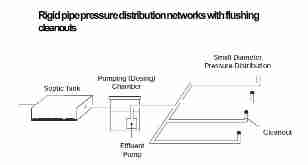 How and When Septic Effluent is Moved Through a Septic System - Methods For Septic Effluent Distribution Using Gravity Systems
How and When Septic Effluent is Moved Through a Septic System - Methods For Septic Effluent Distribution Using Gravity Systems
The page top image shows a sketch of a basic septic system design using gravity dosing, with effluent flowing from a septic tank to a dosing chamber and from there to a drainfield. Image: Indiana state health department. Citation of this article by reference to this website and brief quotation for the sole purpose of review are permitted.
Our sketch (left, source US EPA) shows a generic septic effluent pressure dosing system, combining a septic tank, a dosing tank, a diverter valve,and two septic effluent dispersal loops through a soil absorption field.
Septic effluent is distributed to a system final treatment and disposal using either gravity
methods (which depend on terrain slope -
see GRAVITY/SIPHON DOSING SYSTEMS)
or pressure methods - PRESSURE DOSING SYSTEMS (which use a pump to move effluent to its destination treatment and disposal area). Effluent may be distributed for final soil absorption by several methods listed here:
- Single Effluent Line: A 4" perforated PVC pipe receives effluent by gravity from the septic tank. The pipe is buried in a gravel trench and may be run in a straight line or a loop.
- Distribution Box/Network of Lines A distribution box receives effluent by gravity from the septic tank and routes it to a network of perforated pipes. The network is made of multiple independent trenches which maybe on a flat or sloped site.
- Serial relief line: multiple, serially connected trenches are built on a sloping site and used serially.
- Drop box: multiple independent trenches are built on a sloping site, connected from drop boxes.
- Gravity Dosing, Bell Siphon Dosing, Float Dosing (discussed in this document): 4" perforated pipe, with or without a
distribution box, are installed all at a single elevation.
A hinged "bucket" chamber receives effluent and periodically, as it fills, the bucket tips to spill effluent into
the piping system (A "dipping" or "tipping" system).
Bell siphon dosing systems (a bell and siphon method of moving effluent to the drainfield) or float-controlled (a floating valve opens or closes) septic effluent dosing system designs are also available and are discussed in this document. Gravity dosing systems distribute effluent periodically rather than continuously to the absorption field, letting the field rest between doses and extending its life and capacity. However because the effluent dose is "poured" suddenly into the drainfield, local spot or point overloading may still occur.
Methods For Septic Effluent Distribution Using Pressure Dosing Systems
How septic effluent dosing systems work
Septic effluent dosing systems have an effect on the drainfield much like flushing a toilet: the drainfield may be at rest, then it has to receive a surge of wastewater effluent. The size of the dosing tank or dosing mechanism determines the size of the effluent dose, and the controls on the system (electronic, float, tipping by gravity, etc) set the dosing interval.
To extend drainfield life and/or to accommodate soils with poor percolation rates, some dosing systems, particularly those using mechanical or gravity-operated dosing mechanisms, use alternating siphons or tipping dosers that can flush septic effluent into alternating septic drainfield areas.
Because some solids that flowed out of the septic tank may settle in the dosing tank, it is a good idea to periodically inspect and clean the dosing tank when the septic tank itself is pumped, cleaned, and inspected.
-
Pressure dosing systems, by using pumps and a network of distribution piping, move septic effluent uniformly
from an effluent dosing chamber to the entire absorption system field. Effluent accumulates in a dosing
chamber until it reaches the "dose" level.
A float switch or other control activates an effluent pump to move the effluent dose to the absorption system.
General Specifications for Pressure Dosing Systems and types of pressure dosing systems are described in more detail at PRESSURE DOSING SPECIFICATIONS including pressure manifold dosing systems, rigid pipe network dosing systems, and dripline or irrigation dosing systems. - Non-Pressure Methods of Effluent Handling: Gravity Dosing, Bell Siphon Dosing, Float Dosing:
- DIPPING OR TIPPING DOSING for effluent dispersal: 4" perforated pipe, with or without a
distribution box, are installed all at a single elevation.
A hinged "bucket" chamber receives effluent and periodically, as it fills, the bucket tips to spill effluent into the piping system (A "dipping" or "tipping" system) - FLOAT CONTROL DOSING SYSTEMS are similar to Tipping systems for moving effluent but use a float, typically hinged.
An example of a floating outlet design for dosing systems for septic effluent disposal can be seen in animation at Rissy Plastics FLOUT floating outlet for septic effluent dispersal. - BELL SIPHON SEPTIC DOSING - a bell and siphon
method of moving effluent to the drainfield) and float-controlled septic effluent dosing system designs are also
available.
Gravity dosing systems distribute effluent periodically rather than continuously to the absorption field, letting the field rest between doses and extending its life and capacity.
However because the effluent dose is "poured" suddenly into the drainfield, local spot or point overloading may still occur.
Gravity dosing systems are described in detail at GRAVITY/SIPHON DOSING SYSTEMS
- DIPPING OR TIPPING DOSING for effluent dispersal: 4" perforated pipe, with or without a
distribution box, are installed all at a single elevation.
(Gravity or siphon dosing systems for septic effluent disposal are discussed in more detail just below).
Controlled vs Uncontrolled Effluent Flow When Septic Effluent is Moved Through a Septic System
Wastewater effluent is distributed for final treatment over time either by uncontrolled, or controlled methods.
Uncontrolled septic effluent flow: A conventional gravity septic system and drainfield is "uncontrolled". When waste enters the septic tank, it forces the same volume of effluent out of the tank and into the leach field. Some experts call this a continuous or trickling septic system.
Conventional septic tank and drainfields use this approach. The timing of effluent movement or "trickle" into the absorption field is based simply on when people are using the building plumbing and thus based simply on when wastewater flows out of the building into the septic tank.
Controlled septic effluent flow: in controlled systems effluent is sent to the final treatment and disposal system such as an absorption field under either mechanical control such as a tipping or siphon system or under pump control, such as by use of a septic effluent pressure manifold or a septic effluent drip network.
 In some large wastewater treatment systems
with a significant if not uniformly continuous inflow, outflow of the system may be
continuous in some designs. But many system use an intermittent effluent dosing method which operates by
a pump controlled perhaps by a float in an effluent receiving chamber, or by a siphoning
or tipping bucket mechanical system (gravity systems) which we discuss here.
In some large wastewater treatment systems
with a significant if not uniformly continuous inflow, outflow of the system may be
continuous in some designs. But many system use an intermittent effluent dosing method which operates by
a pump controlled perhaps by a float in an effluent receiving chamber, or by a siphoning
or tipping bucket mechanical system (gravity systems) which we discuss here.
Gravity Dosing System - General: The purpose of septic effluent "dosing" systems is to place septic effluent in the absorption system or drainfield at intervals rather than continuously.
In effect, the effluent dosing chamber forms a "buffer" which receives and stores septic effluent flowing (or being pumped) out of the septic tank until a desired dosing quantity is reached.
Then the effluent is dispersed to the absorption system in one "dose."
By distributing effluent at intervals rather than on a more nearly continuous or irregular basis the absorption system can "rest" between cycles, extending its life and possibly increasing its ultimate effluent treatment and disposal capability.
Not only does the rest interval permit the absorption system more time to dispose of its effluent, also the exposure of the system to air between doses can reduce the rate of clogging of the drainfield.
Bell Siphon Septic Effluent Dosing Systems
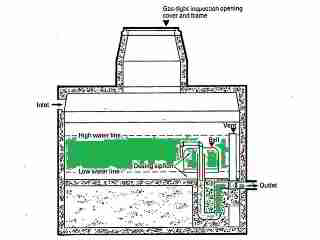 Bell siphon effluent dispersal systems are a septic effluent dosing method that has been in use since about 1900.
Bell siphon effluent dispersal systems are a septic effluent dosing method that has been in use since about 1900.
Bell siphon dosing systems use a bell-shaped cover over a vertical dosing chamber outlet pipe, combined with a vent pipe that lets air out of the bell chamber to control effluent flow.
Illustration at left, courtesy USDA, edited by DF
Effluent level in the dosing chamber rises in both the chamber and inside the bell (through the open bottom of the bell). As effluent rises, air inside the bell vents out through a small-diameter pipe.
When effluent in the dosing chamber reaches the level of the bell-vent pipe outlet (which is letting air out of the bell), liquid rising inside the bell slows (as no more air escapes the bell) and the remaining air trapped inside the bell begins to push out of the dosing chamber outlet pipe and trap.
When effluent reaches the maximum design level in the dosing chamber, air in the trap (at maximum pressure) is expelled through the dosing chamber trap and is followed by the dose of septic effluent, starting a siphon action.
The siphon action moves effluent from the dosing chamber to the absorption field, leach field or sand filter bed.
As effluent leaves the dosing chamber the effluent level in the chamber drops until it reaches the open bottom of the bell. At this point the siphon action is "broken" and siphoning of effluent out of the chamber stops.
Bell siphon effluent dispersal designs deliver a fixed effluent dose to the absorption system or drainfield at a frequency which will depend on the rate of usage of the septic system, or the rate of flow of wastewater into the system.
An example of a bell siphon effluent dosing system including a simple animation can be seen at Fluid Dynamic Siphons,. Contact Fluid Dynamic at 970-879-2494 or info@siphons.com - Steamboat Springs, Colorado. Website: http://www.siphons.com/operation.html
See FLOAT CONTROL DOSING SYSTEMS just below for an updated approach to bell siphon septic system designs.
Also see pressure and gravity dosing discussions
in SEPTIC TANK/SOIL-ABSORPTION SYSTEMS: HOW TO OPERATE & MAINTAIN - EQUIPMENT TIPS [PDF] U.S. Department of Agriculture, 8271 1302, 7100 Engineering, 2300 Recreation, September 1982, retrieved 08/28/2010, original source: http://www.fs.fed.us/t-d/pubs/pdfimage/82711302.pdf.
Dipping or Tipping Septic Effluent Dosing Systems
A septic tipping dosing system, also referred to as a bucket tipping or tipping pan, uses a bucket mounted on an axle or hinge inside of an effluent dosing chamber to first accumulate and then dispense septic effluent to the absorption system (referred to in some countries such as New Zealand and Australia as "filtration disposal trenches".
Effluent flows from the septic tank to the dosing chamber, filling the bucket. As the bucket is hinged near its center line, and because the front of the bucket is wedge shaped, as the bucket fills to a specified level or "dose" of effluent, the weight of the effluent causes the bucket to "tip" forward, spilling its contents into the dosing chamber.
An effluent drain connected at the bottom of the dosing chamber directs the tipped effluent to the drain field or soil absorption system.
The size of the bucket in gallons determines the dose of effluent that it will apply to the drainfield. The rate of fill of the dosing bucket depends of course on the in-flow rate of sewage to the septic tank.
Tipping bucket dosing mechanisms operate without requiring electricity and are an alternative to siphon dosing systems described above and float-controlled dosing systems described below.
Float Control or Floating Outlet Septic Effluent Dosing Systems
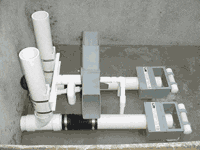 Float controlled septic effluent dispersal systems use a combination of a mechanical float to
open or close the septic effluent holding chamber and gravity to move effluent from the
chamber to the soil absorption system or drainfield.
Float controlled septic effluent dispersal systems use a combination of a mechanical float to
open or close the septic effluent holding chamber and gravity to move effluent from the
chamber to the soil absorption system or drainfield.
An example, the Flout™ from Rissy Plastics is shown in the photo and described here. This model permits alternate dosing between two absorption system sections.
[This description is based on the Flout (TM) float control dosing system component produced by Rissy Plastics and has been reviewed and technical suggestions edited by that manufacturer.
See our link to technical reviewers.]
The patented Flout™ septic effluent dispersal system uses a mechanical Floating Outlet to control effluent holding/discharge cycle.
Effluent flows from the septic tank to directly into the dosing chamber.
A pump may be used to transfer the effluent where the septic tank is lower than dosing chamber.
The Flout blocks discharge from the dosing chamber until the desired volume of effluent is collected.
The Flout floats up on the surface of the effluent until it reaches the upper limit of travel. As more effluent flows into the tank, it over flows into the Flout body causing the Flout to stop floating and to sink to the floor of the chamber, allowing effluent to pass out of the dosing chamber to the absorption system.
Typically a conventional leach field or a raised sand bed filter is used but manufactured wetlands can also be utilized.
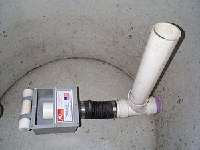 Float-controlled dosing systems operate without requiring electricity (unless a pump is used to move
effluent up to the dosing chamber).
Gravity powers the flow of effluent from the chamber to the soil absorption system.
Float-controlled dosing systems operate without requiring electricity (unless a pump is used to move
effluent up to the dosing chamber).
Gravity powers the flow of effluent from the chamber to the soil absorption system.
The Flout™ may be left mothballed in place at say a vacation home. No extra steps are required to re-activate the system. The Flout never requires priming or recharging of the air bubble like a bell siphon
To handle various dosing volumes or flow rates, floating outlets can be arranged in a single float controlled [image shown here] outlet or alternatively in multiple outlet [shown below] systems.
Designs that alternate between two or more outlets (pictured at the top of this section) permit alternate drain field use, providing for longer rests between dosing cycles. Ganged outlets (double, triple or more Floats operating at once) to provide for larger dosing quantities and flow rates out of the same effluent chamber.
Ganged Flouts like the system shown below also provide the only true parallel effluent distribution, insuring the same amount of effluent flows out of each outlet every time.
Effluent dosing quantities per cycle range from about 30 gallons to 2000 gallons, depending on the size and dimensions of effluent dosing chamber. The Flout™ can have a drawdown of 8" to 52" and should be sized to fit the chamber.
The manufacturer (see below) asserts that this design is easier to install than a bell siphon system. It tolerates out of level conditions better and never requires priming.
Effluent pumping from the septic tank is only needed where the septic tank is lower than the dosing chamber, and simpler, less costly pumps are required than with other dosing systems.
Certainly in comparison with pressure dosing systems (seelinks listed at the ARTICLE INDEX the bottom of this article ) this will be the case.
An example of a floating outlet design for dosing systems for septic effluent disposal can be seen in animation at Rissy Plastics FLOUT floating outlet for septic effluent dispersal.
Gravity Dosing Septic System Design Guides
- Construction Guidelines for Gravity and Flood-Dose Trench Onsite (Septic) Systems, Indiana state health department
- Maintenance of Low Pressure Distribution Septic Systems, Vermont Cooperative Extension
- Dosing Gravity Drainfield Systems, Recommended Standards and Guidance for Performance, Application, Design, and Operation & Maintenance, Washington State Department of Health, July 1, 2007
- SEPTIC TANK/SOIL-ABSORPTION SYSTEMS: HOW TO OPERATE & MAINTAIN [PDF] - , Equipment Tips, U.S. Department of Agriculture, 8271 1302, 7100 Engineering, 2300 Recreation, September 1982, web search 08/28/2010, original source: http://www.fs.fed.us/t-d/pubs/pdfimage/82711302.pdf.
- US EPA ONSITE WASTEWATER TREATMENT SYSTEMS MANUAL [online copy, free] Top Reference: US EPA's Design Manual for Onsite Wastewater Treatment and Disposal, 1980, available from the US EPA, the US GPO Superintendent of Documents (Pueblo CO), and from the National Small Flows Clearinghouse. Original source http://www.epa.gov/ORD/NRMRL/Pubs/625R00008/625R00008.htm Onsite wastewater treatment and disposal systems, Richard J Otis, published by the US EPA. Although it's more than 20 years old, this book remains a useful reference for septic system designers. U.S. Environmental Protection Agency, Office of Water Program Operations; Office of Research and Development, Municipal Environmental Research Laboratory; (1980)
- SEPTIC TANK/SOIL-ABSORPTION SYSTEMS: HOW TO OPERATE & MAINTAIN [PDF] - , Equipment Tips, U.S. Department of Agriculture, 8271 1302, 7100 Engineering, 2300 Recreation, September 1982, web search 08/28/2010, original source: http://www.fs.fed.us/t-d/pubs/pdfimage/82711302.pdf.
- Rissy Plastics, 350 Cedar Lane, Torrington, CT 06790 USA, Tel: 877-221-4426, Email: tanxrus@aol.com, for information about the the Flout™ floating outlet valve dosing system control for septic systems and onsite wastewater disposal.
Please also see ALTERNATIVE DESIGN SEPTIC SYSTEM SUPPLIERS and also review the suppliers listed at ATU Suppliers
Reader Comments, Questions & Answers About The Article Above
Below you will find questions and answers previously posted on this page at its page bottom reader comment box.
Reader Q&A - also see RECOMMENDED ARTICLES & FAQs
On 2018-08-08 by (mod) - How often should I have my dosing tank pumped?
Chris
Thanks for asking an important question.
Given that the septic tank - or what you refer to as the septic trash tank - is intended to hold solids and to allow settling time to permit just clarified effluent to flow out into the gravity dosing tank, the dosing tank itself should stay pretty clean.
I can't give a pumping interval for the dosing tank. To estimate that you'd need to know the size of the septic tank, the daily wastewater flow, and to have some pumping chamber inspection history.
What I would do is have the septic pumping company open the dosing tank to make a visual inspection of its condition.
Take note of the level of settled sludge and (if present) floating scum layer thicknesses.
If those are thick enough to reduce the pumping chamber volume by 1/3 it is certainly time to have the pumping chamber cleaned.
See details at MEASURE SCUM & SLUDGE https://inspectapedia.com/septic/Septic_Tank_Level_Measurements.php
where we give other rules for deciding when to clean a septic tank based on objective data rather than an arbitrary schedule. Those would apply to a pumping chamber as well (a dosing tank), except that in fact the pumping frequency is going to be much less.
And be sure to review
SEPTIC TANK PUMPING SCHEDULE
On 2018-08-08 by Chris
How often should I have my dosing tank pumped? I've never had it pumped but I have my septic trash tank pumped every 3 years, thanks!
On 2016-07-31 - by (mod) -
After cleaning the septic tank your service company can inspect the condition and operation of the bell/siphon.
On 2016-07-31 by rob
my septic was installed in early sixties. 2 chamber tank. bell and siphon. seems to be still working fine but am worried that one day it will quit. is their anything i can do to maintain its operation. tanks are sucked out every 2 years.
On 2016-04-06 - by (mod) -
Steve there are sketches and photos (click to enlarge) in the article above. I doubt that there is one "right" design.
On 2016-04-06 by Steve
What should a septic chamber tipping bucket look like?
On 2015-04-30 - by (mod) -
Readers including our questioner from Alberta about septic tank lids, please Use the "Click to Show or Hide FAQs" link just above to see recently-posted questions, comments, replies
Question: How do I test a gravity syphon box?
(May 24, 2014) Jack said:
How do I test a gravity syphon box?
Reply:
Good question Jack. With the box open watch wastewater entering or simply use a garden hose to fill the receiver to its tipping point, then watch to see the siphon mechanism move water as it should.
Watch out: if your dosing system accumulates a high volume between tipping doses it would be better to inspect the tank several times to see when the tank effluent level is nearly full enough that it should tip the dosing mechanism.
By waiting for the effluent charge to accumulate under normal usage rather than using a garden hose you avoid flooding the system unnecessarily.
Question: safe septic tank lids
30 April 2015 Septic Tank Lids said:
Can you please inform me of the Regulations in Alberta regarding Septic Tank Lids?
We have a concrete Bell & Siphon and I notice the lower and smaller lids (one form each compartment) being are left at the top on the larger lids and under a cover on our concrete patio. When I question the owner of the pump truck company...
he said "that is a good place for them as they are a nuisance...they have to pull them up with a hook.... they get stuck with dirt...and the metal hooks break...and then they have to get down and smash them with a mallet". We have had the same tank system for 40 years and keep it covered and never had a problem until I noticed this recently, that someone had thrown the lower lids on top of the larger lids and under our cover. THak you Jane
Reply:
Sure STL:
Here is an Excerpt from the Alberta septic tank code
3.1.2.3. Access Opening Lid/ Cover
1) All access openings shall be equipped with a secure lid or cover.1
1 Intent: Sentence (1) — To increase safety by preventing unauthorized or accidental entry into the access opening of a septic tank or holding tank. Acceptable protective measures include, but are not limited to, a padlock, a cover that can only be removed with tools, or a cover having a minimum weight of 29.5 kg (65 lb).
2) The opening of a manhole access that extends above ground shall be insulated to an equivalent R-8 insulation value to protect the tank contents from freezing.
In sum, if the cover over your septic tank could be moved by a child so that someone could fall in, the risk is a quick and ugly death. Be sure the covers are safe.
Details are at SEPTIC TANK COVERS
...
Continue reading at SEPTIC SYSTEM DESIGN ALTERNATIVES - topic home, or select a topic from the closely-related articles below, or see the complete ARTICLE INDEX.
Or see these
Recommended Articles
- ALTERNATING BED SEPTIC SYSTEMS
- SEPTIC TANK PUMPING SCHEDULE - when to pump the septic tank
Suggested citation for this web page
GRAVITY/SIPHON DOSING SYSTEMS at InspectApedia.com - online encyclopedia of building & environmental inspection, testing, diagnosis, repair, & problem prevention advice.
Or see this
INDEX to RELATED ARTICLES: ARTICLE INDEX to SEPTIC SYSTEMS
Or use the SEARCH BOX found below to Ask a Question or Search InspectApedia
Ask a Question or Search InspectApedia
Questions & answers or comments about septic dosing systems that do not require a pump or pressure nor electricity..
Try the search box just below, or if you prefer, post a question or comment in the Comments box below and we will respond promptly.
Search the InspectApedia website
Note: appearance of your Comment below may be delayed: if your comment contains an image, photograph, web link, or text that looks to the software as if it might be a web link, your posting will appear after it has been approved by a moderator. Apologies for the delay.
Only one image can be added per comment but you can post as many comments, and therefore images, as you like.
You will not receive a notification when a response to your question has been posted.
Please bookmark this page to make it easy for you to check back for our response.
Our Comment Box is provided by Countable Web Productions countable.ca
Citations & References
In addition to any citations in the article above, a full list is available on request.
- In addition to citations & references found in this article, see the research citations given at the end of the related articles found at our suggested
CONTINUE READING or RECOMMENDED ARTICLES. - Our recommended books about building & mechanical systems design, inspection, problem diagnosis, and repair, and about indoor environment and IAQ testing, diagnosis, and cleanup are at the InspectAPedia Bookstore. Also see our Book Reviews - InspectAPedia.
- Onsite Wastewater Disposal, R. J. Perkins
- In addition to citations & references found in this article, see the research citations given at the end of the related articles found at our suggested
CONTINUE READING or RECOMMENDED ARTICLES.
- Carson, Dunlop & Associates Ltd., 120 Carlton Street Suite 407, Toronto ON M5A 4K2. Tel: (416) 964-9415 1-800-268-7070 Email: info@carsondunlop.com. Alan Carson is a past president of ASHI, the American Society of Home Inspectors.
Thanks to Alan Carson and Bob Dunlop, for permission for InspectAPedia to use text excerpts from The HOME REFERENCE BOOK - the Encyclopedia of Homes and to use illustrations from The ILLUSTRATED HOME .
Carson Dunlop Associates provides extensive home inspection education and report writing material. In gratitude we provide links to tsome Carson Dunlop Associates products and services.


